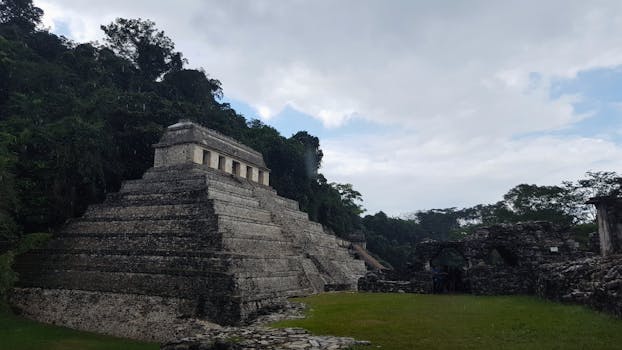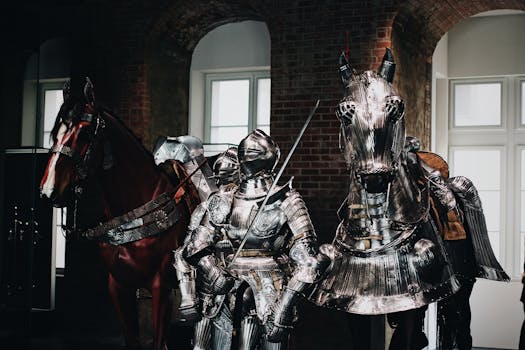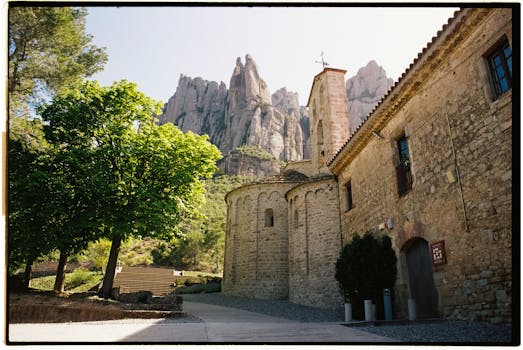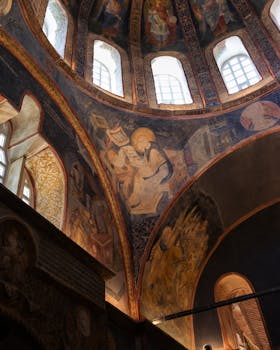Indice
- The Misunderstood ‘Barbarians’: Challenging Historical Stereotypes
- Origins and Etymology: Unraveling the Term ‘Barbarian’
- Roman Perspectives: The ‘Civilized’ vs. the ‘Uncivilized’
- The Goths: From Scandinavia to the Fall of Rome
- Attila and the Huns: Nomadic Warriors of the Steppes
- The Vandals: From Germania to North Africa
- Viking Expeditions: Norse ‘Barbarians’ as Traders and Settlers
- The Mongol Empire: Genghis Khan’s ‘Barbarian’ Legacy
- Cultural Achievements: Art, Technology, and Social Structures
- Warfare and Military Tactics of ‘Barbarian’ Societies
- Religious Beliefs and Practices Among ‘Barbarian’ Groups
- Legacy and Influence: How ‘Barbarians’ Shaped Modern Europe
- Redefining ‘Barbarian’: Embracing Cultural Diversity in Historical Studies
The Misunderstood ‘Barbarians’: Challenging Historical Stereotypes
Historical Context of ‘Barbarism’
The term ‘barbarian’ has long been used to describe various groups that were considered outsiders by more established civilizations, particularly the Romans and Greeks. It often denoted those who did not share the same cultural practices, languages, or social structures. However, labeling these groups as ‘barbarians’ oversimplifies their complexities and downplays their contributions to history. Many of these societies, such as the Germanic tribes, the Celts, and the Huns, had rich cultural traditions, sophisticated social organizations, and influential political systems. Understanding the historical context in which these cultures existed is crucial for reshaping our perception of them.
Culture and Society of the So-Called Barbarians
Contrary to popular belief, many so-called ‘barbarian’ societies were not chaotic or devoid of sophistication. For instance, the Germanic tribes had well-defined social hierarchies, while the Celts were renowned for their artistry, particularly in metalworking and elaborately decorated pottery. Moreover, these cultures maintained their own systems of governance and law, which were often complex and intricate. Such societal structures challenge the notion that ‘barbarians’ operated outside the bounds of civilization, revealing a tapestry of human experience that deserves recognition and respect.
Legacy and Influence on Western Civilization
The influence of these so-called ‘barbarians’ on Western civilization is profound and often overlooked. The fall of the Roman Empire, a pivotal event that shaped European history, was marked by interactions with various barbarian groups, leading to significant cultural exchange and transformation. As these groups settled in former Roman territories, they blended their traditions with Roman practices, contributing to the development of medieval European culture. This legacy can be seen in everything from language to legal systems, illustrating that the ‘barbarians’ played a vital role in the formation of modern European identity. Acknowledging their contributions encourages a more nuanced understanding of history that transcends simplistic definitions.
Origins and Etymology: Unraveling the Term ‘Barbarian’
Historical Roots of the Term
The term ‘barbarian’ originates from the ancient Greek word ‘barbaros’, which referred to non-Greek speakers. The Greeks perceived those who did not speak their language as ‘babblers’ or ‘stutterers’, as their speech sounded incomprehensible to Greek ears. Over time, this term evolved and was adopted by the Romans, who used it to describe various tribes and peoples outside their empire, including Germans, Celts, and even the Huns. This label connoted a sense of cultural superiority, allowing the Greeks and Romans to distinguish themselves from those they considered uncivilized.
Connotations and Misinterpretations
Throughout history, the term ‘barbarian’ carried negative connotations, suggesting a lack of culture, refinement, and societal organization. As the Roman Empire expanded, this label was often used to justify military campaigns against these groups, painting them as threats to civilization. Such representations not only reinforced stereotypes but also fabricated a narrative that dismissed the rich histories and traditions of these cultures. In reality, many so-called ‘barbarians’ had intricate systems of governance, artistic achievements, and philosophies, challenging the oversimplified view imposed by external civilizations.
Modern Reinterpretations
In contemporary discourse, scholars and historians increasingly recognize the limitations of the term ‘barbarian’ and advocate for a more balanced understanding of these ancient cultures. By examining archaeological findings, historical texts, and oral traditions, researchers highlight the complexities of these societies, acknowledging their contributions to human history. This re-evaluation urges us to move beyond the derogatory implications of the term and appreciate the diverse tapestry of human civilization, where exchanges between ‘civilized’ and ‘barbarian’ cultures have shaped the world we know today.
Roman Perspectives: The ‘Civilized’ vs. the ‘Uncivilized’

Roman Views on Barbarism
The Romans had a complex relationship with the so-called ‘barbarians’. While they viewed themselves as the pinnacle of civilization, many Roman writers depicted neighboring tribes as savage and uncultured. This dichotomy of ‘civilized’ versus ‘uncivilized’ was evident in texts by historians such as Tacitus, who portrayed the Germanic tribes with a mix of admiration and scorn. Though he acknowledged their bravery and martial skills, he described them as lacking in the refined culture of Rome. This perspective not only formed a foundation for Roman identity but also perpetuated stereotypes that influenced how these tribes were seen in later centuries.
Military Encounters and Cultural Exchange
The Roman Empire’s expansion often brought them into direct conflict with various ‘barbarian’ tribes, leading to military encounters that were both violent and transformative. Over time, these interactions resulted in significant cultural exchanges. For instance, Roman technologies, infrastructure, and agricultural practices gradually influenced the societies of conquered tribes. Conversely, the Romans adopted certain elements from these cultures, such as the war tactics of the Parthians or the craftsmanship of the Gauls. This symbiotic relationship challenges the one-dimensional view of Romans as purely civilized and ‘barbarians’ as rudimentary, showcasing the dynamic interactions that shaped the ancient world.
The Legacy of Roman Perceptions
The Roman portrayal of ‘barbarians’ has had lasting implications on how these groups were perceived throughout history. This narrative was often adopted and expanded upon by later historians, reinforcing the divide between ‘civilized’ and ‘uncivilized’ peoples. It has influenced literature, art, and popular culture, perpetuating the idea that ‘barbarism’ equated to chaos and disorder. However, as modern scholarship revisits these categories, there is a growing recognition of the contributions of these once-misunderstood cultures. By acknowledging the complexities of Roman perspectives, we can better understand the historical narrative and the rich tapestry of human interactions that define our shared past.
The Goths: From Scandinavia to the Fall of Rome
Origins and Migration of the Goths
The Goths emerged in the region of Scandinavia around the 1st century CE before migrating southward into the territories of present-day Germany and beyond. This movement was largely driven by climatic changes and pressures from invading tribes from the east. By the 3rd century, the Goths had settled in what is now Ukraine, where they established the Visigoths and Ostrogoths, two primary branches that would later play pivotal roles in the history of Europe. Their migration patterns were not merely a search for land, but also a quest for trade opportunities, security, and the establishment of new societal structures.
The Gothic Wars and Their Impact on Rome
The Goths became increasingly involved in conflicts with the Roman Empire, which ultimately contributed to its decline. Notably, the battle of Adrianople in 378 CE was a critical turning point; the Visigoths, led by Fritigern, inflicted a decisive defeat on the Romans, marking one of the first significant victories for a ‘barbarian’ group against Rome. This not only destabilized the empire but also heightened the Goths’ visibility as formidable opponents. The ensuing Gothic Wars, characterized by their fierce battles and complex negotiations, led to significant territorial gains for the Goths, which further cemented their presence in the historical narrative of late antiquity.
Cultural Synthesis and Legacy
Despite their initial portrayal as adversaries, the Goths played an essential role in shaping the transformation of Europe from the classical world to the medieval period. As they settled within the Roman territories, they adopted and adapted various aspects of Roman culture, including governance, military tactics, and religious practices. The conversion of the Goths to Christianity, particularly under the influence of the Arian form of the faith, represented a significant cultural synthesis. This blending of traditions contributed to the formation of new cultural identities that laid the groundwork for the medieval societies that followed. The legacy of the Goths persists in modern times, influencing the development of various European nations and their historical narratives.
Attila and the Huns: Nomadic Warriors of the Steppes

Origins and Lifestyle of the Huns
The Huns were a nomadic tribe originating from Central Asia, believed to have migrated westward around the 4th century CE. Renowned for their exceptional horse-riding skills, they adapted to a nomadic lifestyle that revolved around herding and raiding. This adaptability allowed them to thrive in the harsh and variable climates of the Eurasian steppe. Their society was organized in a tribal confederation, with war bands led by chieftains, most famously Attila, who rose to prominence in the 5th century. The Huns’ ability to utilize their mobility to conduct surprise attacks made them formidable adversaries, creating a reputation that would resonate throughout Europe.
Attila the Hun: The Scourge of God
Attila, who ruled from 434 to 453 CE, became synonymous with Hun power and fear. Under his leadership, the Huns launched a series of devastating campaigns across Europe, striking terror into the hearts of both common folk and seasoned Roman generals. Known as the “Scourge of God,” his conquests included significant victories in the Balkans and Gaul, where he famously besieged the city of Orléans. Attila’s strategy often involved coordinated assaults, using both direct combat and psychological warfare, which allowed him to intimidate his enemies and secure vast territories. His empire, albeit short-lived, reflected the Huns’ profound impact on the geopolitical dynamics of the late Roman Empire.
Cultural Impact and Legacy of the Huns
While the Huns were often depicted as uncivilized barbarians by Roman historians, their interactions with other cultures helped shape the era’s shifting social landscape. They were instrumental in facilitating the migration of various Germanic tribes, contributing to the eventual fall of the Western Roman Empire. The Huns also engaged in cultural exchanges through trade and warfare, impacting Roman military tactics and societal structures. The legacy of the Huns and Attila remains evident in history as a symbol of the tumultuous transition from the classical world to the medieval era. Their story serves as a poignant reminder of the complexities within the narratives of so-called ‘barbarian’ cultures and their essential role in the evolution of European history.
The Vandals: From Germania to North Africa

Origins and Migration of the Vandals
The Vandals were originally part of the larger Germanic tribes inhabiting regions of what is now southern Scandinavia and northern Germany. By the early 5th century, they began their migration southward due to pressures from the Huns and other tribes. They traversed through Gaul and crossed into the Iberian Peninsula, eventually seizing control of parts of modern-day Spain. Their migration was not merely an act of relocation; it was characterized by military campaigns that asserted their dominance over the territories they passed through, marking a pivotal point in the decline of Roman authority in Western Europe.
The Vandal Kingdom in North Africa
In 429 CE, under the leadership of King Genseric, the Vandals crossed into North Africa, where they capitalized on the weakened state of the Roman Empire’s presence in the region. By 455 CE, they had established a formidable kingdom centered in Carthage, which became a powerful maritime base. The Vandals effectively controlled key shipping lanes in the Mediterranean, leading to economic prosperity and political leverage against both the Romans and other emerging kingdoms. This territorial expansion allowed them to maintain a distinct cultural identity while engaging in trade and warfare that would influence the dynamics of the Mediterranean world.
Legacy of the Vandals
The legacy of the Vandals is multifaceted, influencing both the historical narrative of barbarian tribes and the eventual rise of medieval Europe. Their conflict with the Roman Empire, particularly the sacking of Rome in 455 CE, not only illustrated their military prowess but also symbolized the vulnerability of Roman authority. While often vilified in Roman accounts as a savage and destructive force, the Vandals made notable contributions to the regions they controlled, including the promotion of Arian Christianity. Their eventual defeat by the Byzantine Empire in the 6th century led to the term “vandalism,” which endures as a description of senseless destruction, showcasing the lasting impact of their name and reputation throughout history.
Viking Expeditions: Norse ‘Barbarians’ as Traders and Settlers

The Viking Age: A Time of Exploration and Trade
The Viking Age, spanning roughly from the late 8th century to the early 11th century, is often remembered for its notorious raids along the coasts of Europe. However, these Norse people were much more than mere marauders; they were skilled navigators and traders. The Vikings explored vast territories, reaching as far east as the Volga River in Russia, and as far west as Newfoundland in Canada. Their longships allowed them to navigate both open seas and shallow rivers, facilitating a network of trade routes that integrated various cultures. This period saw the exchange of goods such as furs, amber, and spices, showcasing the Vikings’ role as significant traders in the medieval economy.
Settlement and Cultural Assimilation
As the Vikings expanded their territories, they settled in various regions, leaving a lasting legacy that shaped these areas. In England, they established the Danelaw, where Norse law and customs merged with Anglo-Saxon culture, influencing local governance, language, and even place names. Meanwhile, in Ireland and Scotland, Viking settlements contributed to the creation of towns like Dublin and Limerick. The Norse settlers blended their traditions with local cultures, leading to a unique cultural synthesis that enriched the social fabric of these regions. This blending process transformed the initial perception of Vikings as mere raiders into a recognition of them as contributors to medieval European society.
The Legacy of the Vikings as Traders
The Viking expeditions were not solely acts of conquest; they also laid the groundwork for extensive trading networks that endured long after the Viking Age. These networks enabled the exchange of ideas, technologies, and cultures between the Norse and the peoples they encountered. Their interactions with the Byzantine Empire and the Islamic world facilitated a flow of knowledge, enriching both Viking society and those they traded with. Viking craftsmanship, particularly in metalwork and shipbuilding, left a lasting impact on the art and technology of the regions they touched. Today, the Viking legacy continues to be celebrated in popular culture, highlighting the complex identity of these so-called ‘barbarians’ as both traders and settlers in the tapestry of European history.
The Mongol Empire: Genghis Khan’s ‘Barbarian’ Legacy

The Rise of the Mongol Empire
The Mongol Empire, founded in the early 13th century by Genghis Khan, emerged from the steppes of Mongolia, where the nomadic tribes led a lifestyle centered around horse herding and raiding. Genghis Khan, initially born as Temujin, united these disparate tribes through strategic alliances, fostering loyalty among his followers. Under his leadership, the Mongols rapidly expanded their territory, launching campaigns that would create one of the largest contiguous empires in history. The empire’s rise signifies not only military prowess but also the organization and tactics that challenged established civilizations across Asia and Europe, fundamentally reshaping regional dynamics.
Innovations and Administration of the Mongol Empire
Despite being labeled as ‘barbarians’ by contemporaries, the Mongol Empire showcased remarkable innovations in governance and military strategy. The Mongols implemented a meritocratic system that prioritized skill and loyalty over noble birth, allowing non-aristocrats to rise to significant military and administrative positions. They established a vast communication network known as the Yam, facilitating trade and information flow across the empire. Furthermore, the Mongols practiced religious tolerance, allowing diverse cultures and beliefs to coexist, which fostered a rich cultural exchange among the populations they ruled. This adaptability and incorporation of various practices illustrated a sophisticated approach to governance often overlooked by traditional narratives.
The Legacy of the Mongols in World History
The legacy of the Mongol Empire extends far beyond its conquests, influencing trade, culture, and geopolitics for generations. The Pax Mongolica, a period of peace established under Mongol rule, facilitated increased trade along the Silk Road, leading to significant economic and cultural exchanges between East and West. Innovations in warfare, such as siege tactics and mobility, influenced military strategies worldwide. The Mongol impact on regions like China, Persia, and Russia varied, often resulting in significant political and cultural transformations. However, the narrative of the Mongols as mere ‘barbarians’ continues to be debated, as their contributions to world history underscore the complexities of their legacy and challenge simplistic classifications of civilization.
Cultural Achievements: Art, Technology, and Social Structures

Artistic Expression and Craftsmanship
The so-called ‘barbarian’ societies displayed remarkable artistic achievements that were both functional and decorative. The Celts, for instance, are renowned for their intricate metalwork, including intricate jewelry and weaponry adorned with elaborate designs that often featured animal motifs and spirals. Their artistry was not limited to metal; beautiful pottery and textiles have also been discovered, showcasing their sophistication and cultural identity. Similarly, the Germanic tribes’ woodwork and textiles reveal a wealth of creativity, highlighting their skills in crafting objects that were not only utilitarian but carried significant cultural symbolism. Such artistic expressions contribute to modern understanding of these cultures as valuing beauty and craftsmanship alongside everyday function.
Technological Innovations and Agriculture
Barbarian societies were not solely defined by their interactions with Roman civilization; they also developed their own technological innovations that significantly improved their livelihoods. The introduction of advanced agricultural techniques, such as crop rotation and the use of iron plows, led to increased food production and population growth. Additionally, the adaptation of the horse collar improved efficiency in farming and transport, allowing for greater mobility and trade. The Scandinavian Vikings, known for their shipbuilding skills, created longships that facilitated exploration, trade, and raiding, showcasing their advanced understanding of maritime technology. These technological advancements reflect a level of ingenuity that belies the simplistic notion of ‘barbarism’.
Social Structures and Governance
Contrary to the perception of chaos among barbarian tribes, many of these societies had well-defined social structures and systems of governance. For instance, the Germanic tribes operated under a mix of tribal governance and customary laws, with councils and assemblies that allowed for collective decision-making. The use of chieftains or kings, who were often elected based on merit, points to an organized political system that valued individual reputation and loyalty. In the case of the Huns, while they were more nomadic, their confederation of tribes under strong leaders like Attila allows us to see a form of military organization and unity against common enemies. These social structures illustrate the complexity of governance in so-called barbarian societies, offering a more nuanced understanding of their communities and cultures.
Warfare and Military Tactics of ‘Barbarian’ Societies

Military Organization and Strategies
Many so-called ‘barbarian’ societies displayed remarkable military organization and effective strategies that contributed to their success in warfare. The Germanic tribes, for instance, often assembled large, coordinated forces capable of engaging in complex battle tactics. They utilized shock tactics, employing swift strikes and ambushes to disorient better-trained Roman legions. Similarly, the Huns, renowned for their horse-riding skills, developed a mobile warfare strategy, allowing them to launch quick, unexpected attacks. Their agility on horseback, combined with psychological warfare, instilled fear among their adversaries. This adaptability demonstrates that these societies were far from primitive; rather, they exhibited a deep understanding of military strategy and troop dynamics that often caught their enemies off guard.
Raiding and Expansion
Raiding was a common military tactic among several ‘barbarian’ cultures, serving both as a means of acquiring resources and asserting dominance over rival tribes. The Vikings, for example, became infamous for their raiding expeditions across Europe, targeting monasteries, trading centers, and settlements. Their longships allowed them to navigate rivers and coastal areas effectively, facilitating rapid assaults and subsequent retreats. This tactic not only provided necessary supplies but also expanded their territories and influence. Concurrently, the Vandals employed similar strategies during their incursions into Roman territories, culminating in their capture of Carthage. Such raids exemplify how these societies balanced aggression with strategic resource management, reinforcing the notion that they were skilled military actors in their own right.
Cultural Exchange through Warfare
Warfare often served as a catalyst for cultural exchange between so-called ‘barbarian’ groups and established civilizations, such as the Roman Empire. As these tribes invaded or settled in conquered areas, they assimilated various cultural practices, technologies, and military innovations. For instance, the Goths adopted Roman military tactics and administrative practices after their interactions with Roman forces, which significantly influenced their governance and martial strategies. Similarly, the Huns affected the military organization of their adversaries, prompting a reevaluation of traditional tactics among Roman commanders. This interplay between conflict and cultural exchange challenges the notion of barbarism, highlighting the complexities of interactions across ancient civilizations and furthering the advancement of warfare strategies and societal development.
Religious Beliefs and Practices Among ‘Barbarian’ Groups

Spiritual Beliefs and Deities
Many so-called ‘barbarian’ groups had rich spiritual beliefs and pantheons of deities that reflected their understanding of the world and their environment. For instance, the Celts worshipped a multitude of gods and goddesses associated with nature, fertility, and war, often performing rituals in sacred groves or at natural features like rivers and mountains. Their reverence for nature is evident in their mythology, where many deities were tied to natural phenomena. Similarly, the Germanic tribes embraced a pantheon that included gods like Odin, Thor, and Frey, and their religious practices involved rituals, sacrifices, and festivals that maintained a close connection to their warrior culture. These practices illustrate that ‘barbarian’ religions were deeply woven into the fabric of their societies, shaping their identities and cultural expressions.
Rituals and Ceremonies
Rituals and ceremonies played a vital role in the lives of various barbarian societies, fulfilling communal and spiritual needs. The Celts, for instance, celebrated seasonal festivals such as Samhain and Beltane, which marked significant points in the agricultural calendar and involved feasting, bonfires, and sacrifices to appease their deities. Such rituals reinforced community bonds and cultural identity. Moreover, the Germanic tribes conducted various rites of passage, including initiations and funerals, that reflected their beliefs in the afterlife and the spiritual journey of the individual. These ceremonies often included the sharing of stories and songs that preserved their lore, showcasing a strong oral tradition alongside their religious practices.
Christianization and Adaptation
With the advent of Christianity, many ‘barbarian’ groups experienced significant religious transformations as they interacted with the Roman Empire and missionaries. The conversion of the Goths and Vandals to Christianity, particularly the Arian form, illustrates how these societies adapted and incorporated new beliefs while still maintaining elements of their indigenous practices. The Christian church often repurposed existing sites of worship, leading to a blending of customs and traditions. For example, many early Christian festivals aligned with pagan celebrations, ensuring a smoother transition for the populations. This process of Christianization not only reshaped their religious landscapes but also influenced their social structures and governance, marking a crucial intersection of cultures that further defined the trajectory of medieval Europe.
Legacy and Influence: How ‘Barbarians’ Shaped Modern Europe

The Cultural Fusion Post-Roman Empire
The fall of the Roman Empire marked a transformative period in European history, characterized by the influx of various ‘barbarian’ groups into former Roman territories. As these groups, such as the Goths, Vandals, and Franks, settled in these regions, they brought with them unique cultural practices, languages, and social customs that intermingled with the remnants of Roman society. This cultural fusion laid the groundwork for the medieval European identity, where elements of Roman governance, law, and language blended with indigenous traditions. The result was a new societal framework that incorporated diverse influences, leading to the evolution of distinct medieval cultures that would shape the future of Europe.
The Transformation of Governance and Law
The impact of ‘barbarian’ groups on the governance and legal systems of Europe cannot be overstated. As they established their kingdoms, they adapted Roman administrative structures to fit their tribal customs and practices. The Franks, for example, under leaders like Charlemagne, embraced the Roman tradition of centralized governance, which allowed for the consolidation of power and the establishment of a more organized state. This adaptation paved the way for the development of feudalism, a system that became a hallmark of medieval Europe. Moreover, the legal codes introduced by various barbarian tribes influenced the evolution of customary law, highlighting the significant role these groups played in reshaping governance structures across the continent.
Religious Syncretism and Identity Formation
The influence of ‘barbarian’ groups also extends to the religious landscape of Europe, where the integration of pagan beliefs and Christian doctrine resulted in a unique syncretism. As tribes converted to Christianity, they often retained elements of their traditional practices, resulting in a rich tapestry of spiritual expression. This blending is evident in various holy days and celebrations that incorporated pre-Christian customs, illustrating how the ‘barbarian’ cultures contributed to the shaping of Christian practices in Europe. The establishment of new saints, local rituals, and the adaptation of church architecture reflect this interplay and demonstrate the complexities of identity formation in a post-Roman world. The legacy of these interactions continues to resonate in modern European culture, showcasing the lasting impact of those once labeled as ‘barbarians’.
Redefining ‘Barbarian’: Embracing Cultural Diversity in Historical Studies

Recognizing Cultural Contributions
The reevaluation of the term ‘barbarian’ within historical narratives fosters an appreciation for the cultural contributions made by these once-marginalized groups. Rather than being regarded solely through the lens of conflict and chaos, it’s essential to acknowledge the innovations, artistic expressions, and governance structures they established. Cultures such as the Celts, Goths, and Vandals left profound marks on European civilization through their advancements in art, trade, and social organization. Encouraging a perspective that values their legacies contributes to a more inclusive understanding of history that honors the diverse human experience.
Interconnected Histories and Cultural Exchange
The interactions between so-called ‘barbarians’ and established civilizations highlight the rich tapestry of cultural exchange that defined ancient history. Through trade, conflict, and migration, these groups influenced one another, leading to the development of shared practices, technologies, and cultural norms. For instance, the blending of Roman and Germanic traditions after the fall of the Empire illustrates how identities and traditions are not static but evolve through mutual influence. This interconnectedness reinforces the importance of viewing history as a dynamic field shaped by a multitude of voices and experiences.
Challenges of Simplistic Labeling
As modern scholarship advocates for a nuanced approach to understanding ancient cultures, it is imperative to challenge the simplistic labeling that has historically defined groups as ‘civilized’ or ‘barbarian’. Such binary distinctions overlook the complexities of human societies, their intricate social structures, and their contributions to global history. By redefining our understanding of ‘barbarism’, historians can pave the way for a broader, more inclusive narrative that recognizes the depth and richness of humanity’s diverse cultural legacy. Engaging with these complexities encourages critical perspectives that resonate in contemporary discussions about identity and cultural understanding.





